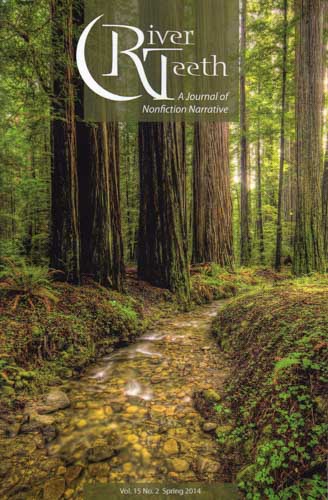River Teeth – Spring 2014
The editors of River Teeth are candid about their selection process. About half of what they publish comes from unsolicited submissions. The rest may come from authors whose work they’ve heard at conferences, online or regional publications, commissioned work, or from friends, acquaintances, and the editors themselves. “We know all this sounds more than a little intuitive,” writes the editor, “even presumptuous, and quite a bit less than arm’s length. That’s the nature of love, we guess.”
In this issue, animals, parenting, and the nature of memory are the doors authors use into insights about life.
The editors of River Teeth are candid about their selection process. About half of what they publish comes from unsolicited submissions. The rest may come from authors whose work they’ve heard at conferences, online or regional publications, commissioned work, or from friends, acquaintances, and the editors themselves. “We know all this sounds more than a little intuitive,” writes the editor, “even presumptuous, and quite a bit less than arm’s length. That’s the nature of love, we guess.”
In this issue, animals, parenting, and the nature of memory are the doors authors use into insights about life. The first sentence in the first essay, Leila Philips’s “Water Rising,” establishes the use of animals as agents of epiphany: “Beavers are the Shiva of the animal world.”
Kim Todd’s “Curious,” describes centuries of scientific fascination with the Surinam toad and its unusual method of reproduction in order to explore the nature of curiosity itself (“When elements previously thought of as incompatible are harnessed together—a juxtaposition—the curiosity grows stronger”). She then applies her conclusions to the craft of writing, so that a layered unity of thought and purpose emerges.
In the beautifully written “What I Learned from a Cockfighter,” Christopher Bundy tries manfully not to over-romanticize an off-the-grid good ol’ boy, but he does. And the idea that fighting roosters are just doing what they are born to do (tear each other apart) skates close to excusing violence as an appropriate first response to provocation, or even to mere proximity. His essay will make you argue with him and with yourself.
The essay that ties the issue together is Michelle Herman’s “Truth, Truthiness, Memory, and Bald-faced Lies—and the Pleasures of Uncertainty.” Nonfiction writers, drawing so much on the capital of memory and charged with “not making it up,” have a different relationship to truth than a novelist, who is trying for verisimilitude rather than the verifiable. In playing with the uses of truth in fiction and nonfiction, Herman comes to a counter-intuitive realization: In nonfiction, you can say, if you have to, I don’t know. But in fiction, you are responsible for making all of it “true” and so can’t opt out of creating the “true” lie, down to the least detail. In the end, both kinds of narrative search for meaning: “Meaning is always available to us if we are interested in finding it, interested in exploring it. In the ‘truth’ or in the apparent truth.”
Several essays use animal behavior as a prism through which to view the vulnerability of children. In “Fish,” Marley Andino agonizes over how to save a younger sister from a sexually dangerous environment. When she moves close by and becomes caretaker of a trout farm, hoping to become a stabilizing influence in the sister’s life, at first she makes headway. Then the trout start dying—it’s not her fault, but that of their environment—and we see that only the predator, a wild kitten lurking around the tanks, will benefit.
The perils of rearing children are much on the minds of these writers, as in the similarly fearful “On Kids and Bombs (or How To Be a Hummingbird)” by Steven Church and Joe Mackall’s “Reflections of a Moderately Disturbed Grandfather.” Lest anyone think that terrorism is a modern phenomenon, Chelsea Biondolillo’s “In Memoriam” tells what happened to the Guanches of the Canary Islands. She too dissects memory—memories from immediate sensory impressions and historical memory, both sadly impermanent. “A memory is an electro-chemical action. It is an event, like lightning, rather than an artifact . . . We understand memories biochemically in two distinct ways: first, as a phenomenon created, and second as a perception retrieved.” As the author struggles to preserve each and every impression of an ecology field trip, she becomes aware of the faint traces of, first, the Canary Islands before civilization; and second, of the history of the Guanches who settled them only to be exploited and ground under by the Spanish Conquest. For anyone understandably concerned about preserving her own store of memories and about being remembered, the lesson of the Guanches is sobering:
It is only a handful of accounts in yellowing pages and crumbling artifacts that tether what we are now to what they were then. The fragile neural networks of a scant number of scholars and activists keep a memory of the Guanches like a light. We cannot hope to account for every life lived, logic asserts.
And isn’t that the point of journals like River Teeth? We write to be remembered. The best of this issue sends memorable messages outward in space and forward in time.
[www.ashland.edu/riverteeth]





